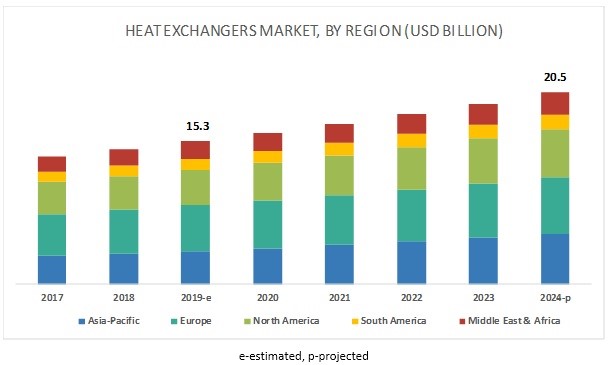Shell & Tube type segment dominated the heat exchangers market in 2018
Shell & tube is the most widely used types of heat exchangers that accounted for the significant share of the heat exchangers market in 2018. Shell & tube heat exchangers can manage fluids at high temperatures and pressures due to which they are preferred in a variety of applications such as chemical, petrochemical and oil & gas, food & beverage, and power generation.
Energy segment is expected to register the fastest growth rate in heat exchangers market during the forecast period
The energy segment, which includes the petrochemical and oil & gas sector, is expected to register the most rapid growth rate during the forecast period. This high growth can be attributed to heat exchangers growing demand in the upstream and downstream processing industry globally. Increasing consumption of petrochemical products has increased the activity in the upstream processing especially across the Middle East & Africa and North America region which is expected to favor the growth of the heat exchangers market globally.
Europe led the heat exchangers market, and APAC region is forecasted to register the highest growth rate during the forecast period
Based on the region, the heat exchangers market is segmented into Asia Pacific, North America, Europe, South America, and the Middle East & Africa. Currently, Europe is the largest market for heat exchangers. The region has huge installed plant capacities of heat exchangers. The heat exchangers market is also emerging in various countries such as China, India, Saudi Arabia, and Brazil due to increasing industrialization.

Asia-Pacific is expected to be the fastest growing region. This is attributed to numerous factors such as a large consumer base (chemical industry, oil & gas refineries, sugar industries, food industry, and others), increase in demand for heat exchangers in countries such as China, India, Japan, and South Korea, for energy generation through nuclear power, and others.
Key Benefits for Heat Exchangers Market:
- The report provides an in-depth analysis of the forecast along with the current and future market trends
- The heat exchangers market forecast is studied from 2019 to 2026.
- This report highlights the key drivers, opportunities, and restraints of the market along with the impact analyses in the forecast period
- Porter’s five forces analysis helps analyze the potential of the buyers & suppliers and the competitive scenario of the heat exchangers industry for strategy building
- A comprehensive analysis of the factors that drive and restrain the market growth is provided
- The qualitative data in this report aims on market dynamics, heat exchangers market trends, and developments
- Heat exchangers market size is provided in terms of revenue
- An extensive analysis of various regions provides insights that are expected to allow companies to strategically plan their business moves
- The profiles of key players along with their key strategic developments are enlisted in the report
Heat Exchangers Market Segments:
The global heat exchangers market is segmented based on type, end-user industry, material of construction, and region.
Key Market Segments:
By Type
- Shell & Tube
- Plate & Frame
- Air-Cooled
- Microchannel
- Others
By End-user Industry
- Chemical
- Petrochemical
- Oil & Gas
- HVACR
- Food & Beverage
- Power Generation
- Others
By Material Of Construction
- Carbon Steel
- Stainless Steel
- Nickel
- Others
By Region
- North
America
- U.S.
- Canada
- Mexico
- Europe
- Germany
- France
- Spain
- Italy
- UK Russia
- Rest of Europe
- Asia-Pacific
- China
- Japan
- India
- South Korea
- Australia
- New Zealand
- Malaysia
- Indonesia
- Philippines
- Thailand
- Vietnam
- Rest of Asia-Pacific
- LAMEA
- Saudi Arabia
- UAE
- Kuwait
- Qatar
- South Africa
- Rest of LAMEA
